Once upon a time, all marketers cared about was how to create a killer ad for a newspaper, magazine, and TV. Then came the Internet and all sorts of digital marketing tactics ensued. Fast track to the present, marketing appears to be shouldering things like digital transformation and customer experience (CX).
But do we know what we’re doing, or why we’re doing it?
Here is an outline of what each section in this article talks about:
- The rising power of consumers and why marketers need to take CX seriously
- The current CX maturity level and the traditional marketing thinking that brought marketers to this stage
- Why and how the traditional thinking persists when it comes to CX](#traditionalthinking)
- The new way of thinking: useful tools and concepts for a more holistic CX approach
- How CX delivers financially and what marketing can do to take on a proactive role
- Frequently asked questions
Customer experience is the brand
Amazon’s CEO Jeff Bezos said: “If you make customers unhappy in the physical world, they might each tell six friends. If you make customers unhappy on the Internet, they can each tell 6,000 friends.”
This is a cliché response to why CX is important, but it deserves the repetition because marketers (or any other profession) can sometimes get caught in their own bubble.
Consumers hold the power in the digital era.
It’s not just the possibility of (negative) word of mouth that should drive the CX engine. It’s also the realisation that customers are more demanding and hold more power, which can make or break a business.
They are more demanding:
- Technological advancements have set the expectations for timeliness, convenience, seamlessness etc.
- Companies with superior CX become the measurement standard
They hold more power :
- Competition between brands (partly due to the growing number of startups and new ventures) has given them more choices
- It’s increasingly easier for people to connect, collaborate and take collective action, to the point of Us (consumers) vs. Them (corporations). Think of peer-to-peer platforms, consumer forums, online petitions and so on
How well are we “doing” CX?
Does the following picture sound familiar to you? The marketing department talks up a good game and customers buy the story, skyrocketing expectations of flawless delivery. The experience worsens as the customers are “handed down” to different departments like sales and customer support.
And it’s not that marketers don’t realise this. A study in 2016 showed that most companies in Australia and New Zealand assess themselves as “not very advanced” in CX.
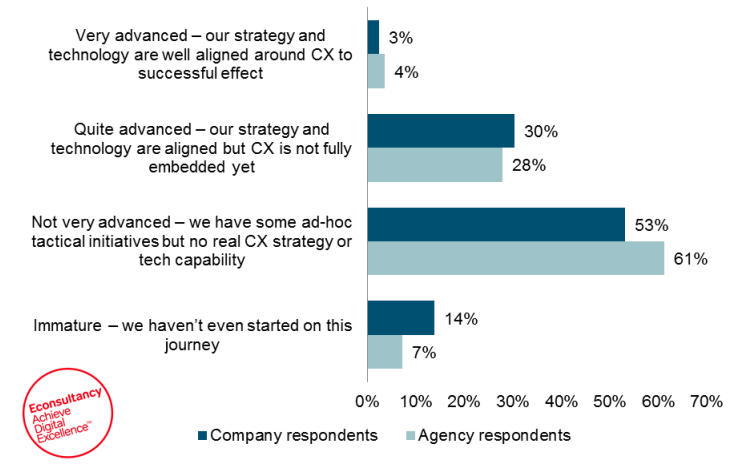 Source: eConsultancy
Source: eConsultancy
It’s 2017 now and yet the campaign-based mentality is still pervasive in the marketing sphere. Why?
Because we’ve all learned the well-known marketing funnels, which represent linear journeys. Remember the AIDA model or its extended version such as AIDAS and AIDCAS?
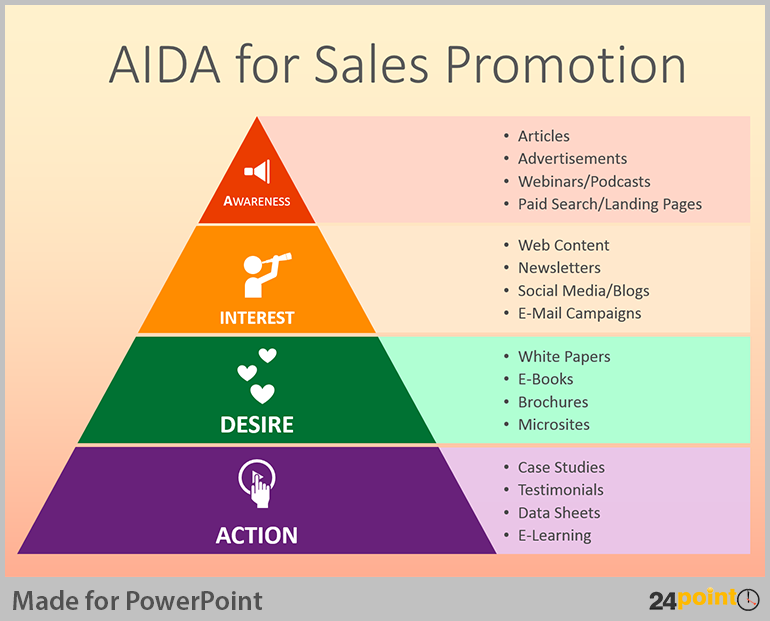 Soure: 24point0
Soure: 24point0
Although recent developments have led to the recognition of more emotional elements in the marketing funnel, or that customers don’t always convert in a linear manner, marketers are still thinking about CX in terms of marketing communications, or the Promotion part in the traditional 4Ps.
We assume we’re “doing CX” by adopting the “best practices” for each stage of the customer journey. Examples:
- Running analytics on the marketing funnel
- Creating and testing more creative variations
- Increasing marketing automation capability
Doing these can lead to risks such as a lack of linkage to other stages, or the marketing operations becoming too rigid and formulaic.
Beware of these mentalities within marketing
Being stuck in the old ways hinders the progress of improving CX.
Content-centric: focusing on creating content for the sake of it, and then try to find distribution channels
Channel-centric: focusing on touch points instead of overall journey (customer journey mapping is different from touchpoint mapping)
Department-centric: reluctant/unable to share data between sales, marketing, customer service
To bring things into perspective, let’s consider some familiar scenarios that marketers don’t want to admit being in:
- Marketing uses social media to broadcast messages but ignores customers’ requests for help or more info
- Churning out content that’s not relevant, that is repetitive or rhetorical
If the situation goes on unaddressed, the gaps that marketing is meant to close will get wider.
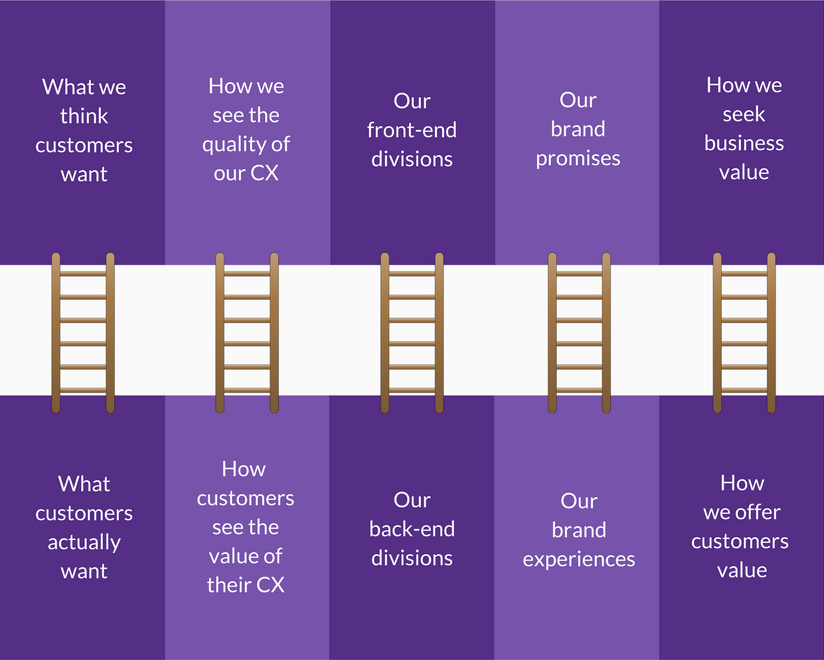 Gaps preventing companies from delivering great CX
Gaps preventing companies from delivering great CX
The role of marketing communications in CX
“Brand marketing is not the only way to get customers started on their buying journey,” and certainly not the only way to get them to stay.
Marketers often forget that CX looks at factors in the purchasing journey from the customer’s perspective, not the business’. This snapshot from a McKinsey study shows how varied the influence of touchpoints can be in different stages of CX.
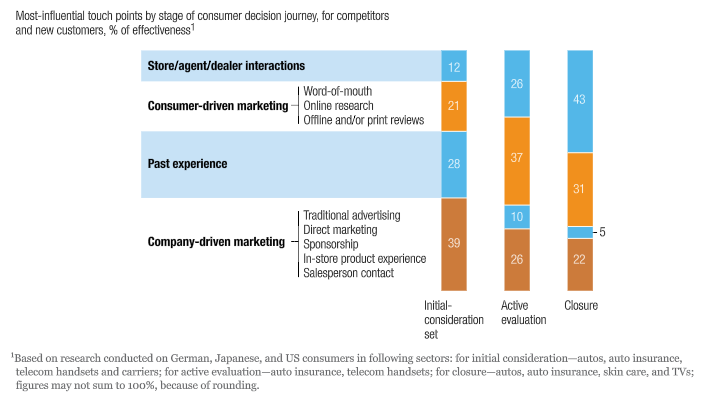 Source: McKinsey
Source: McKinsey
The rising popularity of movements such as inbound and content marketing has proven the need for brands to step away from the “push” mode (and into the “pull” mode). A counterintuitive lesson is power sometimes comes from surrendering a bit of control on the brand’s part:
- Communications need to include a “service” flavour: help customers achieve their goals
- It’s less about behavioural tracking or being creepy (warning: retargeting marketing)
- There might be a need to transform marketing operation rather than improving and managing individual touch points
Who owns what?
Nobody owns the customer experience, let alone manage it. When the “CX management” responsibility falls on the shoulders of marketing, “we own the environment, but act like we own the effect.” This is like the campaign-centric, touchpoint-centric mentalities we’ve discussed above.
One way to deconstruct an “experience” is looking at its composition: environment, encounter, and effect. See the graph below for some marketing-related examples.
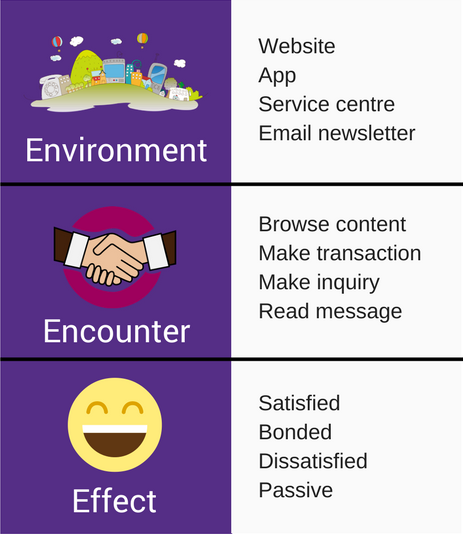 Elements of experience plus examples. Source: University of Amsterdam
Elements of experience plus examples. Source: University of Amsterdam
The “encounter,” or “moments” are what we should focus on, because they symbolise the present – the time and place where the experience forms. As simple as it sounds, if you think about it, it’s a powerful realisation. We create the environment in anticipation of a future, we ask customers about their past feelings, yet we don’t understand what they try to do now.
We don’t manage their experience, but we can at least manage their expectations of the experience. User-centric platforms (e.g. Uber, Airbnb) set the expectations for customers right from the start (not full-time taxi drivers; not fully fledged hotel services).
Think beyond marketing
We should strive to understand what customers want to do, more than who they are.
Useful concepts & tools
This is where “Jobs-to-be-done” comes in. We’ve written about it in another blog post from a product development standpoint, but this concept is equally applicable to marketing and CX.
As marketers, we’ve all heard of customer journey mapping. If we look at the similarities, both jobs to be done and customer journey mapping:
- Combine actions, emotions, thoughts or functional, social, emotional jobs of customers
- Show the importance of context and pain points
- Help you work out opportunities to appeal to their emotional decision making process, among things like success points, persuasion points, and unconscious triggers to act
- Look at not just customers, but also customers of your customers, end-users etc.
What about the differences between the two? Some can argue jobs to be done is more useful in situations where the whole CX needs to be redesigned, while journey mapping is more about mapping out what’s already there and optimising the CX.
“We should strive to understand what customers want to do, more than who they are.”
Another tool we’ve stumbled on in marketing is empathy map. These are used to construct buyer personas. There’re also different types of personas: goal-directed, role-based, engaging, and fictional.
We’re not here to discuss how to deploy them, but to illustrate the fact that buyer personas – or the knowledge of your customers – are only a part of the equation.
Towards a holistic approach
The best approach might be to combine the best of everything, such as this customer experience map of Rail Europe. It’s important to note though, that this map doesn’t include how different personas might go through the journey differently.
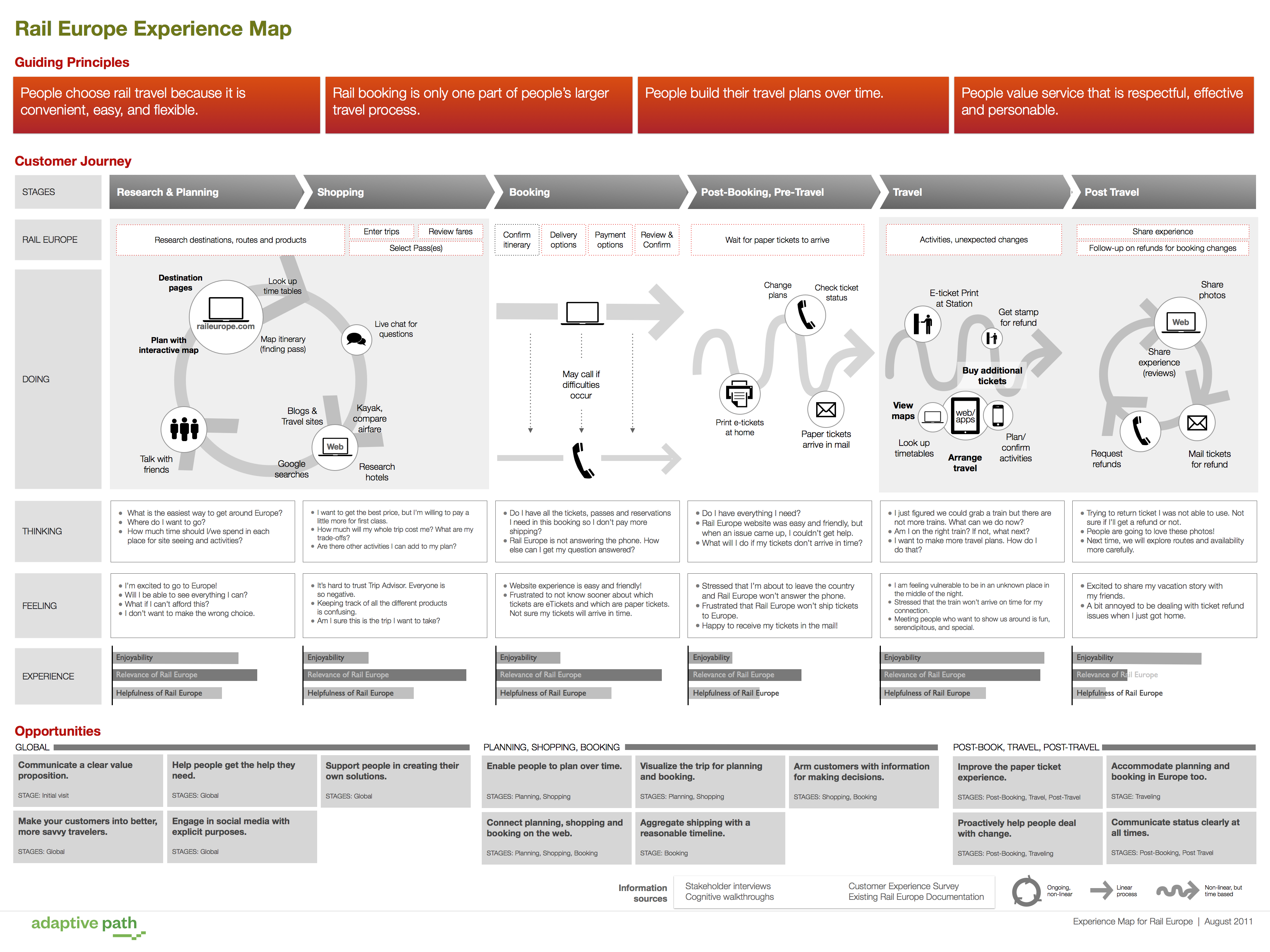 Source: Adaptive Path
Source: Adaptive Path
How do you know if it’s enough to just map out a generic/typical journey rather than one for each persona? To answer this, you need to go back to examine the nature of your business:
- Do different personas warrant differential treatment for economic reasons?
- Do different personas wish to have such differential treatment (e.g. because you’ve set the expectations)?
- Is your product complex as it includes numerous, non-linear journeys?
To put things in perspective:
- For those wishing to have their Internet installed at a new premise, they couldn’t care less about anything else than getting it done soon => consider goal-based personas
- For those who identify with a particular user segment, either implicitly (a repeat user vs. a passer-by) or explicitly (Economy vs. Business class), there are opportunities to greatly enhance their CX, and also higher risks of shattering it due to expectations => consider engaging or fictional personas
Yet another approach is to map out a baseline journey while adding variations based on what each customer profile values, as shown in the diagram below.
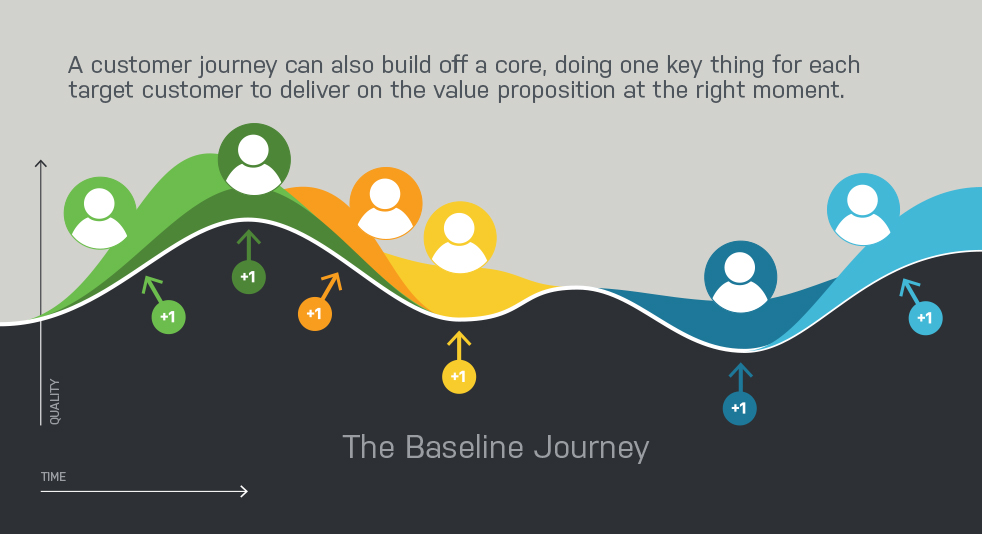 Source: Adaptive Path
Source: Adaptive Path
Marketing needs to take the initiative
CX is not just a fluffy, feel-good concept. Though tricky to measure, superior CX drives superior revenue growth. There’s also data to back it up, in addition to common sense (i.e. Why wouldn’t customers want to repurchase from a business they had a good experience with?).
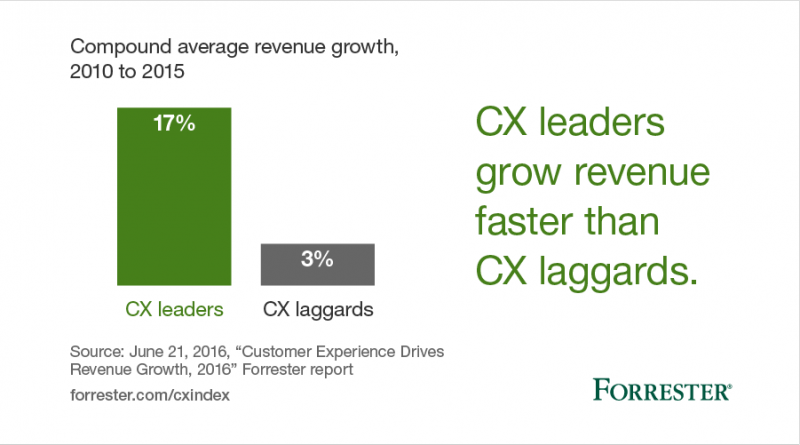 Source: Forrester
Source: Forrester
“Customers who had the best past experiences spend 140% more compared to those who had the poorest past experiences” – Peter Kriss, Harvard Business Review.
If you still need more proof, companies who were Leaders on the CX Index did better in terms of stock value over an eight-year period.
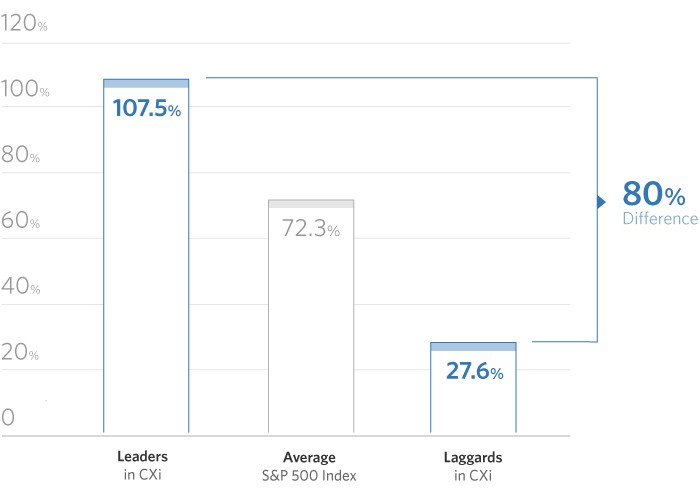 Source: Watermark Consulting
Source: Watermark Consulting
So why wouldn’t marketing want to take a proactive role in driving the business forward? To tackle CX at a strategic level, consider looking at it through three lenses and two sub-lenses (or filters):
Human
- Internal: realise that we’re more similar than we’re different, i.e. working for the same organization
- External: have empathy for people who buy and use our products, because we’re also consumers elsewhere
Business
- Internal: deploy a shared CX mission, KPIs, incentives for cross-department collaboration
- External: deploy loyalty, referral, user feedback and improvement programs
Technology
- Internal: use tech to enhance CX initiatives e.g. shared data/portal, internal communication, automated workflows
- External: give customers transparent data along the journey (e.g. progress bar, overall picture)
“We don’t manage customers’ experience, but we can at least manage their expectations of the experience.”
FAQs
Q: Where does CX start and end?
A: “The complete story of the customer journey with your product or service. From start to finish. It’s how a customer finds, interacts, and ends the relationship with you and your product.”
Q: What’s the difference between CX and UX?
A: CX may be broader in a sense it covers both purchasers and users. On the other hand, UX may only be specific to those who actually use a given product. However, at the end of the day, what’s more important to address: a terminology issue or a mindset issue?
Q: Can a superior product be ruined by bad CX or can superior CX make up for a bad product?
A: Yes, a superior product can be ruined by bad CX in the long run; and no, a bad product can’t be saved by superior CX in the long run. The main thing is to think beyond the cycle of anyone in power, whether in business or government; or to avoid corporate short-termism. There is data to show companies operating with a long-term view outperform their peers.


